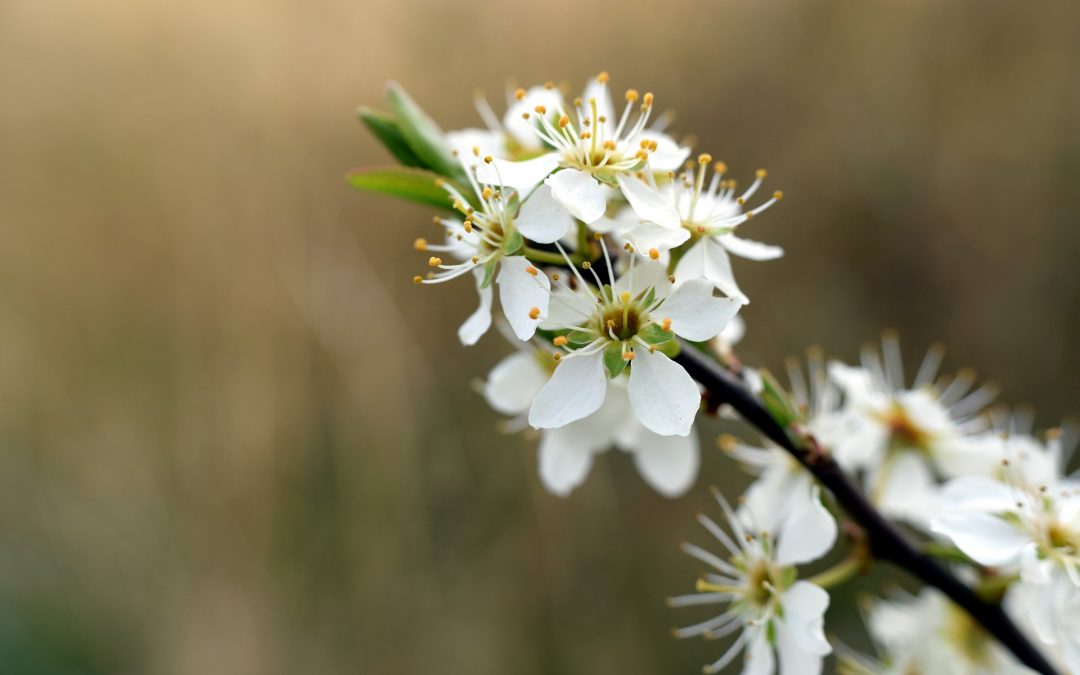If you live in Kansas City and are into gardening — you’re lucky! KC straddles the humid subtropical South and the humid continental climate of the North, with cool winters and long, hot summers. So you get the best of both worlds in native plant varieties. Landscaping with native plants will save you work and money. Native plants and flowers for Kansas City typically need less maintenance, use less water, and provide a natural habitat for local wildlife. They’re energy-efficient and eco-friendly as well.
The list of native trees, shrubs, and flowers for KC is long. Let’s start with the choices for flowers when it comes to hardiness and ease of care:
1. White Hawthorne Blossom
It’s easy to see why Missouri named the white Hawthorne blossom (pictured above) as the official state flower in 1923. This woody plant can reach 20 feet high. It’s beautiful and functional. The fruit makes a tasty jam and provides food for birds and other native critters.
2. Sunflower
OK, so it’s the state flower of Kansas, but what says the plains of the midwest better than the sunflower? This iconic, drought-resistant plant will grow just about anywhere but loves the sunshine on our side of the river. Left on its own, it will spread, so it needs thinning every few years. It’s an excellent plant for borders or along fences.
3. Cardinal Flower
Photo credit: likeaduck on Visualhunt.com/ CC BY-SA
As the name suggests, this plant produces vivid red flowers from July to September. Because that’s the dead of summer, the cardinal flower will do best in the shade. Make sure to give it room. Its blooms can soar 4 feet high.
4. Bluestar
Great when you need some color in the spring. The flowers are delicate blue, and the plant will stay a vibrant green through the summer and then turn to a nice gold in autumn.
5. Thickspike Gayfeather
This tube-shaped flower adds a touch of purple to your garden, and butterflies and hummingbirds love it!
6. Blue False Indigo
This spring perennial gets its name from the early settlers who used it as a substitute for true indigo to make blue dye. The seed capsules are popular in dried arrangements.
7. Christmas Fern
Although KC is on the western fringe of its native habitat, this evergreen fern is a perennial that adds variety to a garden. It also works well in an indoor hanging basket near a sunny window.
The Kansas City Native Plant Initiative has a wealth of information on native plants and flowers to Kansas City. The organization works to encourage gardeners to plant them instead of the invasives which threaten them.
Bonus! Native Shrubs and Trees
When settlers came west and cleared the land, they virtually wiped out native shrub species. As towns and cities grew, developers opted for European and Asian shrubs, but now the natives are making a comeback. Our native trees are among the hardiest.
Any discussion of trees must begin with the flowering dogwood, the state tree of Missouri. You’ll find it at the edges of forests and in many neighborhoods. The red mulberry is easy to grow but has a bad reputation for producing juicy berries that stain everything they touch. Male cultivars available in nurseries do not have this trait.
The hardy pecan drops a bountiful crop of nuts after the first freeze, and a sycamore that soars to 100-feet will impress your neighbors. Missouri even has its own magnolia tree called the cucumber tree because it produces blossoms that look like, well — cucumbers!
The fringe tree is sometimes called old man’s beard because of its drooping clusters of white flowers in the spring. Fragrant sumac likes sunshine and tolerates drought well, and hazelnut produces an edible nut. Eastern witch hazel holds the distinction of being the last shrub to bloom in Missouri in November and December.
Although Kansas City has a wealth of hardy native plants and averages 42 inches of rain per year, the area is susceptible to occasional drought. Summer of 2018 was particularly bad. Winters are generally mild, but periodic extreme temperature dips can hurt plants. Native plants and flowers for Kansas City have acclimated to our climate, and withstand the changes and brighten up your landscape for years to come.
Looking to learn more about lawn care and gardening in Kansas City? Visit our Kansas City Lawn Care page.

